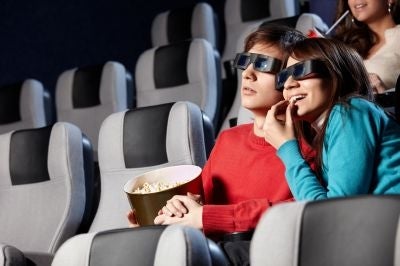Your support helps us to tell the story
From reproductive rights to climate change to Big Tech, The Independent is on the ground when the story is developing. Whether it's investigating the financials of Elon Musk's pro-Trump PAC or producing our latest documentary, 'The A Word', which shines a light on the American women fighting for reproductive rights, we know how important it is to parse out the facts from the messaging.
At such a critical moment in US history, we need reporters on the ground. Your donation allows us to keep sending journalists to speak to both sides of the story.
The Independent is trusted by Americans across the entire political spectrum. And unlike many other quality news outlets, we choose not to lock Americans out of our reporting and analysis with paywalls. We believe quality journalism should be available to everyone, paid for by those who can afford it.
Your support makes all the difference.One year after a 3-D film opened Cannes for the first time ever, Hollywood is in the grip of a revolution that has generated billions of dollars and sent cinema-goers flocking back to theaters.
But industry heavyweights and analysts have warned that the 3-D bonanza could be jeopardized if studios sacrifice quality in order to cash in on movie-making's most important technological milestone since color films.
While James Cameron's science-fiction epic "Avatar" provided ground-breaking confirmation of what 3-D at its immersive best can offer, the Greek mythology remake "Clash of the Titans" was an illustration of what can go wrong.
"Avatar" was conceived and shot using state-of-the-art 3-D cameras - Cameron said he waited for technology to "catch up" with his imagination - "Titans" was shot in 2-D and hastily converted into 3-D during post production.
"A few more 3-D spectacles like 'Clash of the Titans' and audiences will be clamoring for 2-D," was the withering assessment of the Wall Street Journal.
Jeffrey Katzenberg, the respected head of Dreamworks Animation, was similarly scathing, warning in a recent interview with Variety that the movie industry was at a a "genuine crossroads."
Movie-goers who have been happy to pay more at the box-office for quality 3-D will quickly wise up if they feel they are being served up an inferior product, Katzenberg warned.
"We've seen the highest end of 3-D (in 'Avatar') and you have now witnessed the lowest end of it (in 'Titans')," Katzenberg said.
"You cannot do anything that is of a lower grade and a lower quality than what has just been done on 'Clash of the Titans'. It literally is 'OK, congratulations! You just snookered the movie audience.'

Watch Apple TV+ free for 7 days
New subscribers only. £8.99/mo. after free trial. Plan auto-renews until cancelled

Watch Apple TV+ free for 7 days
New subscribers only. £8.99/mo. after free trial. Plan auto-renews until cancelled
"We may get away with it a few times but in the long run, (moviegoers) will wake up. And the day they wake up is the day they walk away from us and we blew it," Katzenberg added.
Lew Harris, the managing editor of thewrap.com website, said the experience of "Clash of the Titans" could have implications for persistent speculation that classic films such as "Star Wars" and "Titanic" may be re-released in 3-D.
"I think it depends on how they do it," Harris told AFP. "By the time these films come out a lot of the 3-D novelty is going to be over.
"And a lot of people are going to be tired of paying for 3-D, particularly if there are lots of films where the 3-D hasn't been good.
"Will people go and see 'Titanic' in 3-D? I think they might, just out of curiosity. It's a 'big' movie. You've got the huge spectacle of a ship sinking, people plunging into the water. It would be an interesting 3-D experience."
But Harris also believes Hollywood will need to be selective in determining which films from the past can be repackaged in 3-D.
"They're going to have to be careful that people don't get turned off," he said. "In a lot of cases it's questionable how much the 3-D really adds to the experience. Disney's talking about 'Beauty and the Beast' in 3-D.
"But they're going to have to prove that 3-D adds enough of a differentiation. I saw 'Up' in 3-D and I don't think there was anything I would have lost by having seen it in 2-D."
David Wertheimer, the chief executive of the University of Southern California's Entertainment Technology Center and the former president of Paramount Digital Entertainment, said artistic obstacles sometimes prevented films from being successfully converted into 3-D.
"Most people don't realize that there is an 'art' to making great 3-D," Wertheimer said in comments emailed to AFP. "It's not just about the technology and creating a second eye view.
"Most 3-D films being distributed today have 3-D in mind from conception. The shots in those films are being staged and framed differently.
"They're being edited differently to maximize the 'effect' that the depth has on the story and the experience.
"The problem with converting live action movies from 2-D to 3-D is that some of the creative choices that the director and DP (director of photography) originally made are different from how you would want them in 3-D.
"It is sometimes impossible to make comfortable 3-D out of 2-D shots that are framed in a certain fashion. So, it's an entirely new creative process in converting that film to 3-D."
Yet Wertheimer believes classic films such as "Star Wars" and "Titanic" could be successfully converted provided the makers of the original films are closely involved in the process.
"In the hands of the original creators, the likelihood of success is great (assuming enough time and budget to do it right)," he wrote.

Join our commenting forum
Join thought-provoking conversations, follow other Independent readers and see their replies
Comments